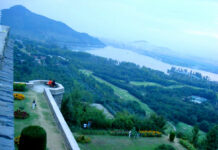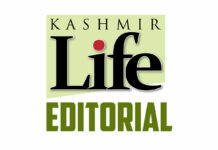Quietly, in the last three decades, a major shift in Kashmir’s food fundamentals took place—the onus of feeding the population phenomenally shifted from growers of the state to the Food Corporation of India (FCI). Two factors played a pivotal role— the state’s halt in deciding the basic minimum price and purchasing huge quantity of paddy, and massive conversion of agricultural land into the apple orchards. Farmers so desperate to improve their earnings jumped to high-yielding horticulture plus inter-cropping. The race was so fierce that even farmers failed to detect that they were compromising their own food security pushing them from being producers to buyers.
For many decades now, more than two-third of Kashmir’s food requirements are being sourced from Punjab, Haryana, and parts of UP. Kashmir’s own rice Bowles have phenomenally reduced to a symbolic three. But as long as markets are integrated, Kashmir is unlikely to sleep hungry.
But the issue of food security requires to be taken seriously because the supply lines are unstable for reasons of geography and politics. While the system of rationing will have to improve, there is much dire requirement of encouraging the agricultural scientists to work on this front. If they are unable to offer a high-yielding variety to the farming community, they better hunt for the same in other parts of the world. Kashmir desperately needs a variety that yields very high, so that the remaining swaths of paddy fields become economically viable for their owners. A better yielding variety can help reverse the conversion of agricultural land into horticulture and commercial spots. SKUAST scientists should be asked to take this job as a challenge and benchmark of their performance.
At the same time, the political executive will have to take another challenge head-on— the mass feeding of the population. This issue, that has started resonating from certain urban streets in wake of NFSA extension to the state, is actually the continuation of an old mess that rulers have introduced and retained. Feeding non-farming population has been genuinely a major extension of various pre-1947 regimes. Then, there was no elaborate system of purchase and transport, and a hungry and malnourished population was key to destabilize the empires they had occupied. Over the years, the system has changed, so has the demography.
The last survey carried out by the now-non-existent planning commission of India had put the percentage of poverty in J&K as slightly more than five percent. Given the BPL population was getting much lower, the state had to fight a long battle and eventually it was agreed upon that 26 percent of population in J&K is living below poverty line. This apparently was aimed to retain the huge commerce that is part of public distribution system. Thus commerce is a huge pressure group in politics.
Now, when the ruling PDP-BJP government decided to implement Food Security Act, a key reform that NC-Congress alliance skipped implementing, it has created a new challenge. FSA is clearly supportive of poor and seeks a bit extra from the population living above the ceiling.
Given a section of population against the idea, the government is apparently nervous. There are voices suggesting serious review, if not a roll back. Finding it suiting it’s politics, the ruling coalition may opt for an about-turn, if the front pages continue to remain adverse.
It is at this critical juncture that leadership requires some sort of steadfastness. If this reform fails, other reforms will also face the same fate. A person, who can own a car, a cell phone and has all the basic facilities of life, must pay for his food. It is not important for economics alone but it is more important to help people regain their dignity as human beings. Kashmir must start coming out of it’s Hatou days.









